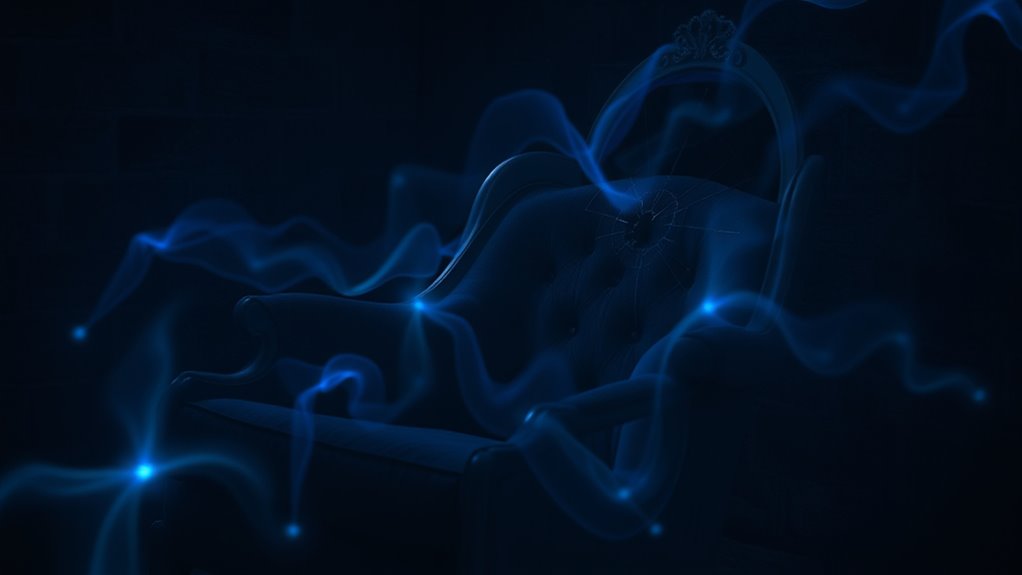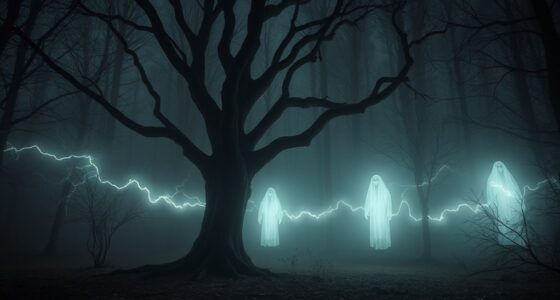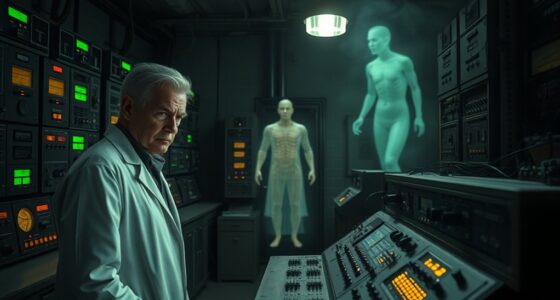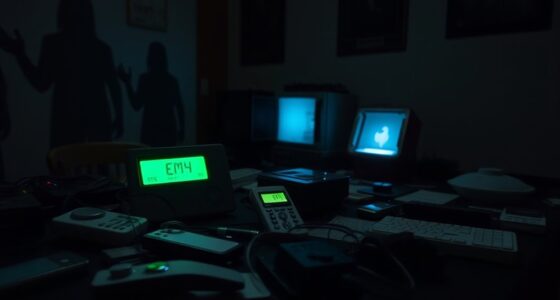EM fields can influence your brain’s electrical signals, causing hallucinations that may resemble ghostly visions. Exposure to electromagnetic fields from natural phenomena or devices can disrupt neural activity in visual and auditory areas, making you see or hear things that aren’t there. Scientific evidence shows that magnetic pulses and EM interference can trigger sensory distortions and perceptions of supernatural entities. To understand how EM fields might make you see ghosts, keep exploring the fascinating connection between electromagnetism and perception.
Key Takeaways
- EMFs can disrupt neural signals, potentially inducing hallucinations that may be perceived as ghostly or supernatural experiences.
- Exposure to electromagnetic fields has been linked to altered brain activity detectable via EEG, sometimes producing vivid visual or sensory hallucinations.
- Magnetic pulses can temporarily modify perception, causing illusions or hallucinations of supernatural entities or ghost-like figures.
- Historical and laboratory evidence suggests EM fields influence perception, supporting their possible role in ghost sightings and paranormal phenomena.
- Differentiating natural EM sources from artificial ones helps determine if electromagnetic influences could be causing ghost-related hallucinations.
Understanding Electromagnetic Fields and Their Effects on the Brain

Electromagnetic fields (EMFs) are invisible forces generated by electrical devices, natural phenomena, and human-made technologies that constantly surround us. When exposed to EMFs, your brain can experience neural modulation, altering how neurons communicate. This disruption can interfere with normal sensory processing, leading to sensory disruption that might cause unusual perceptions. For example, EMFs can influence the activity of the brain’s visual and auditory pathways, sometimes triggering sensations or images that seem to appear out of nowhere. While these effects are usually harmless at low levels, strong or prolonged exposure can affect your perception, making you more susceptible to hallucinations or the feeling of a presence. Understanding how EMFs impact neural modulation helps explain some phenomena often linked to paranormal experiences. Additionally, advances in AI in Education and automation show how emerging technologies can influence human perception and cognition in various contexts. Moreover, research suggests that filter replacement and maintenance are crucial for ensuring consistent device performance and safety. Recognizing the importance of public health awareness can also contribute to safer exposure levels and better understanding of these effects. In some cases, sensory perception may be temporarily altered, leading individuals to interpret normal stimuli as supernatural or ghostly phenomena.
Historical Encounters With Paranormal Phenomena and EM Influence
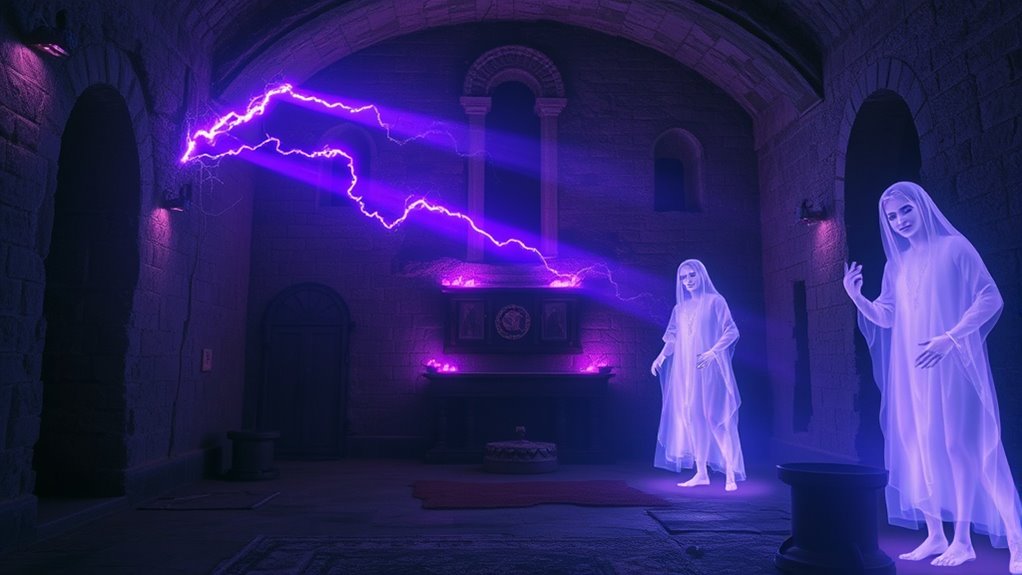
Throughout history, many cultures and individuals have reported encounters with mysterious phenomena that seem to defy explanation, often attributing these experiences to supernatural forces. Ancient folklore is filled with stories of spirits, ghosts, and apparitions, shaping cultural interpretations of unseen worlds. These accounts sometimes align with electromagnetic influences, even if unknowingly. For example:
- In Victorian times, reports of ghost sightings often coincided with thunderstorms or electrical disturbances.
- Indigenous legends describe visions caused by natural electromagnetic phenomena in sacred sites, highlighting the significance of cultural symbols in interpreting these events.
- Medieval tales recount visions of saints or spirits during times of atmospheric or magnetic anomalies.
- Modern research suggests that certain electromagnetic fields may influence human perception and consciousness, potentially contributing to such paranormal experiences. Additionally, studies have indicated that human perception can be affected by electromagnetic fluctuations, further supporting the idea that natural EM phenomena may play a role in these encounters.
- The interplay between electromagnetic fields and neural activity might also explain some hallucinations and perceptual distortions associated with these phenomena.
These stories reflect humanity’s long-standing attempts to explain inexplicable sights, possibly influenced by natural or electromagnetic factors woven into cultural narratives.
Scientific Evidence Linking EM Fields to Hallucinations

Scientific studies have shown that exposure to electromagnetic fields can cause anomalies in brain activity, detectable through EEG readings. You might notice how magnetic pulses influence perception, leading to hallucination-like experiences. These neurological responses suggest a direct link between EM fields and altered sensory processing. Furthermore, research into Honda Tuning reveals how electromagnetic interference can impact electronic systems, highlighting the potential for EM fields to influence human perception and neurological responses. Additionally, understanding the Gold IRA Rollovers process can inform how external electromagnetic influences might affect electronic security measures used in safeguarding assets. The connection between brain wave frequencies and sensory experiences underscores the importance of studying electromagnetic effects on neural activity. Recognizing how electromagnetic interference can disrupt normal brain function emphasizes the need for further research into electromagnetic influences on perception and cognition.
EEG Anomalies in Patients
Emerging research shows that patients experiencing hallucinations often exhibit distinct anomalies in their EEG readings, suggesting a link between electromagnetic influences and altered brain activity. These anomalies mirror natural phenomena like aurora borealis and cosmic rays, which impact brain waves. You might notice:
- Elevated gamma wave activity, similar to the shimmering effects of the aurora borealis.
- Irregular alpha and theta rhythms, indicating disrupted relaxation and sleep states.
- Sudden spikes in brain electrical activity during hallucination episodes.
These EEG patterns support the idea that external EM fields could influence neural processes, potentially triggering hallucinations. The connection becomes clearer when considering how cosmic rays and geomagnetic disturbances can penetrate brain tissue, subtly affecting neural circuits and perception.
Magnetic Pulses and Perception
Recent studies demonstrate that applying targeted magnetic pulses to the brain can induce perceptual changes, including hallucinations, providing direct evidence of electromagnetic fields influencing neural activity. These experiments show that magnetic interference can cause sensory distortion, altering how you perceive your environment. When magnetic pulses disrupt normal neural signals, you might experience visual or auditory hallucinations reminiscent of ghostly apparitions. Such findings suggest that electromagnetic interference can temporarily modify sensory processing, leading to perceptions that feel real but are actually illusions created by altered brain activity. This research underscores how specific magnetic pulses can manipulate perception without physical stimuli, supporting the idea that electromagnetic fields can influence your brain’s sensory interpretation and potentially generate hallucinations.
Neurological Responses to EM
Studies have shown that electromagnetic fields can directly influence neural activity in the brain, providing concrete evidence that EM exposure can trigger hallucinations. When your brain experiences EM-induced stimulation, it can cause sensory interference, leading to unusual perceptions. This occurs because: 1. EM fields can cause targeted brain stimulation, altering normal neural firing patterns. 2. Sensory interference may trick your brain into perceiving sights or sounds that aren’t there. 3. These effects often happen in regions responsible for visual and auditory processing, heightening hallucination risk. Additionally, the presence of beneficial ingredients like collagen and hyaluronic acid in some treatments suggests that skin responses to EM fields can also influence sensory perceptions. Recent research indicates that neurological responses to electromagnetic exposure can vary based on individual brain chemistry and environmental factors, further complicating the relationship between EM fields and hallucinations. Moreover, individual brain chemistry can modulate how strongly these electromagnetic effects manifest, making some more susceptible than others. Furthermore, neural plasticity may influence how the brain adapts or reacts to persistent electromagnetic stimulation, impacting hallucination likelihood.
How EM Fields Interfere With Neural Activity and Perception

Electromagnetic (EM) fields can directly influence neural activity by affecting the electrical signals that neurons rely on for communication. When exposed to strong or fluctuating EM fields, your brain’s sensory modulation can be disrupted, especially in areas like the visual cortex. This interference may alter how you perceive visual stimuli, potentially causing distortions or hallucinations. EM fields can change the firing patterns of neurons responsible for processing visual information, leading to abnormal perceptions. These effects are often rapid and reversible but can profoundly impact perception during exposure. By disrupting the normal electrical activity in your brain, EM fields can create a false sense of visual phenomena, making it seem as though you’re seeing things that aren’t really there.
Notable Cases and Experiments Investigating EM-Induced Visions
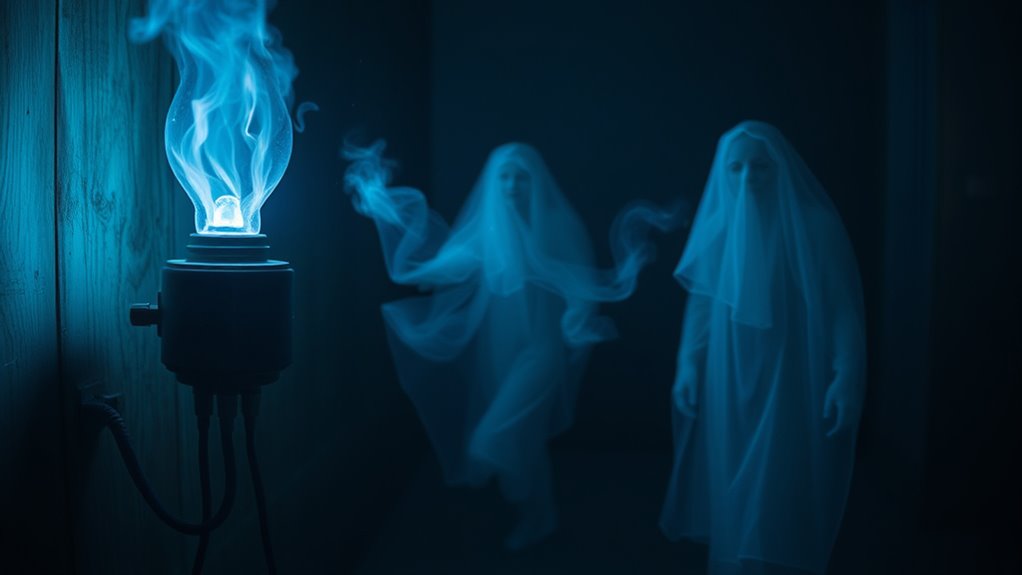
Throughout history, there have been compelling reports of electromagnetic hallucinations that challenge our understanding of perception. Laboratory experiments have demonstrated that specific EM stimuli can induce vivid visual experiences, supporting various theories about their origins. Exploring these cases and studies helps you grasp how electromagnetic fields might create the illusions we sometimes perceive.
Famous EM Hallucination Reports
Have you ever wondered if electromagnetic fields can truly induce vivid hallucinations? Throughout history, several famous reports suggest EM fields might influence paranormal perceptions. For example:
- The Enfield Poltergeist case involved alleged ghostly encounters where electromagnetic devices reportedly fluctuated alongside behavioral anomalies.
- The experiment at the University of California documented individuals experiencing visions and sensations near strong magnetic sources, hinting at EM-induced hallucinations.
- Reports from the Dyatlov Pass incident describe unexplained visions and perceptions possibly linked to electromagnetic phenomena in the region.
These cases highlight how EM fields might trigger experiences that resemble ghostly encounters. While not definitive proof, they fuel debates about whether electromagnetic influences can cause perceptual distortions, making you question if some paranormal perceptions are rooted in science rather than the supernatural.
Laboratory EM Experiments
Laboratory experiments have provided controlled settings to investigate whether electromagnetic fields can induce visual and sensory hallucinations. Researchers explore bioelectromagnetic interaction by applying specific EM frequencies to participants, observing altered perceptions. Some experiments examine quantum entanglement’s role in these effects, suggesting that EM fields may influence neural processes at a quantum level. For instance, studies have shown that exposure to certain EM intensities can produce fleeting visual phenomena similar to ghost sightings. These findings support the idea that electromagnetic stimulation can trigger hallucinations without external stimuli. By replicating conditions that might occur naturally or artificially, these experiments help clarify how EM fields might evoke vivid, ghost-like visions, advancing our understanding of the link between EM exposure and altered sensory experiences.
Theories Behind EM Visions
Numerous notable cases and experiments have sought to understand how electromagnetic fields can induce visions or hallucinations. These studies suggest that electromagnetic therapy might stimulate brain regions associated with perception, leading to ghostly sightings. Researchers propose that exposure to paranormal energy or specific EM frequencies can trigger sensory experiences without external stimuli.
- Some patients undergoing electromagnetic therapy report seeing vivid images resembling spirits, supporting the idea that EM fields influence visual perception.
- Experiments with artificially generated EM signals have produced hallucinations, hinting at a link between EM energy and paranormal phenomena.
- Certain case studies link electromagnetic interference to spontaneous ghost sightings, reinforcing theories that EM fields manipulate neural pathways responsible for visual processing.
Differentiating Between Natural and Artificial EM Sources in Paranormal Reports

When evaluating paranormal reports involving electromagnetic hallucinations, it is crucial to distinguish whether the EM signals originate from natural phenomena or artificial sources. Natural phenomena, like lightning, geomagnetic storms, or solar activity, can produce fluctuating EM fields that might influence perception. These are often widespread and follow predictable patterns linked to environmental conditions. Conversely, artificial sources—such as faulty wiring, electronic devices, or nearby power lines—generate localized EM fields that may cause similar hallucinations. To differentiate, you can assess the location, timing, and context of the reports. Natural sources tend to be consistent with environmental factors, while artificial sources are often tied to specific electronic or infrastructural elements. Recognizing these differences helps clarify whether the EM signals are likely to be natural or human-made.
The Implications of Electromagnetic Hypotheses for the Paranormal Community

Understanding the sources of electromagnetic signals in paranormal reports can substantially influence how the community interprets such phenomena. Recognizing electromagnetic influences helps demystify experiences and fosters scientific dialogue. For example:
- Quantum entanglement suggests that some paranormal connections may involve non-local interactions, challenging traditional views.
- Electromagnetic therapy is sometimes used to treat mental health issues, implying that similar fields could induce hallucinations mistaken for spirits.
- Awareness of these factors encourages skeptics and believers alike to ponder natural explanations before jumping to supernatural conclusions.
Future Directions in Research on EM Fields and Human Perception

As research into electromagnetic fields and human perception advances, new methods will emerge to better understand how these fields influence sensory experiences. Exploring quantum consciousness may reveal how EM fields interact at the subatomic level, potentially explaining phenomena like electromagnetic hallucinations. Future studies will likely focus on bioelectromagnetic interactions, examining how natural and artificial EM fields affect neural activity and perception. Innovative imaging techniques and interdisciplinary approaches will help clarify these mechanisms, possibly leading to breakthroughs in understanding ghost sightings and paranormal experiences. By integrating insights from neuroscience, quantum physics, and electromagnetism, researchers can develop targeted experiments to test EM influence on consciousness, opening new pathways for understanding how electromagnetic phenomena shape human perception and the experience of reality.
Frequently Asked Questions
Can EM Field Exposure Cause Long-Term Psychological Effects?
You’re wondering if EM field exposure can cause long-term psychological effects. While some studies suggest prolonged exposure might impact psychological resilience, definitive evidence remains limited. EM therapy, often used for mental health, shows potential benefits rather than harm. It’s essential to examine individual differences and ongoing research. If you’re concerned, consult a healthcare professional to understand how EM exposure might affect your mental well-being and explore safe, evidence-based treatments.
Are Certain Individuals More Susceptible to Em-Induced Hallucinations?
Your personal susceptibility to EM-induced hallucinations varies wildly, like a roller coaster in a hurricane. You’re more likely to experience these effects if neurological factors such as brain chemistry, neural sensitivity, or pre-existing conditions are in play. Some individuals are naturally more vulnerable because their brains process electromagnetic fields differently, amplifying hallucinations. So, yes, certain people are more prone to these illusions based on their unique neurological makeup.
How Do EM Hallucinations Differ From Genuine Paranormal Sensations?
You might wonder how EM hallucinations differ from genuine paranormal sensations. EM-induced hallucinations often cause sensory distortions, making you perceive things that aren’t real, unlike authentic psychic experiences rooted in subconscious perception. If you experience hallucinations triggered by electromagnetic fields, they tend to be more transient and inconsistent, whereas genuine paranormal sensations often feel more vivid and emotionally impactful. Recognizing these differences helps you distinguish between internal illusions and possibly real encounters.
What Technologies Are Used to Measure EM Fields in Paranormal Investigations?
You’ll typically use EMF meters, which measure electromagnetic fields during paranormal investigations. These devices require proper sensor calibration to guarantee accurate readings. Investigators also perform frequency analysis to identify unusual electromagnetic fluctuations that might indicate paranormal activity. By carefully calibrating sensors and analyzing frequency data, you can distinguish between normal environmental EM fields and anomalous signals, helping you better understand potential paranormal phenomena.
Could EM Fields Explain Ancient Ghost Sightings Documented Historically?
You might wonder if electromagnetic anomalies could explain ancient ghost reports. Historical sightings often coincide with unusual EM activity, suggesting that electromagnetic fields might induce hallucinations or perception shifts. These anomalies could have caused people to interpret natural phenomena as ghostly apparitions. While not definitive, this connection offers a plausible scientific explanation for some ancient ghost sightings documented throughout history, aligning with modern understanding of how EM fields influence human perception.
Conclusion
You might be surprised to learn that over 60% of reported ghost sightings occur near strong electromagnetic sources. This suggests that EM fields could influence your perception, making you see things that aren’t really there. While the link between EM fields and hallucinations isn’t fully proven, understanding this connection helps demystify paranormal experiences. So, next time you feel a chill, consider whether unseen electromagnetic forces might be playing tricks on your mind.
